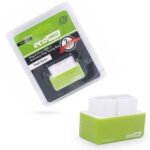Experiencing issues with your Infiniti G35’s OBD2 port can be frustrating, especially when it prevents you from diagnosing potential problems with your vehicle. If you’re facing a situation where your OBD2 scanner fails to connect to your G35, and you’re possibly experiencing other electrical issues like a no-start condition or warning lights, you’re in the right place. Let’s explore the common causes and troubleshooting steps for a non-functional OBD2 port in a G35.
Symptoms of a Faulty G35 OBD2 Port
When your G35’s OBD2 port isn’t working correctly, you’ll likely notice a few key symptoms:
- OBD2 Scanner Connection Failure: This is the most direct indicator. Your scan tool will fail to link or communicate with the car’s computer.
- “Service Engine Soon” Light Off (Even with Issues): The check engine light might be completely off, even when other symptoms suggest engine or sensor problems. This can indicate a power or circuit issue affecting the engine control module (ECM).
- Car Won’t Start: In some cases, a malfunctioning circuit related to the OBD2 port can also affect the car’s ability to start.
- Warning Lights Illuminated: You might see other warning lights such as “VDC OFF” and “SLIP” lights, which can be related to electrical system glitches.
Potential Causes and Troubleshooting
A non-working OBD2 port often points to electrical issues. Here are some potential culprits and how to investigate:
1. Blown Fuse
This is the most common and simplest issue to check. The OBD2 port, along with other vehicle systems, is protected by fuses. A blown fuse can cut power to the port, preventing communication.
- Check the Fuses: Locate the fuse boxes in your G35 (typically under the hood and inside the cabin). Consult your owner’s manual to identify the fuse specifically for the OBD2 port or the “diagnostic port,” “ECM,” or “engine control” fuses.
- Inspect and Replace: Visually inspect the fuse. A blown fuse will have a broken wire inside. Even if it looks okay, try replacing it with a fuse of the same amperage rating.
2. Wiring Issues
Problems in the wiring harness leading to the OBD2 port can also cause it to malfunction.
- Inspect Wiring: Carefully examine the wiring around the OBD2 port and trace it back as far as you can. Look for:
- Damage: Frays, cuts, or exposed wires.
- Loose Connections: Ensure the connector at the back of the OBD2 port is securely attached.
- Corrosion: Check for any signs of corrosion on the connector pins or wiring.
3. OBD2 Port Damage
The OBD2 port itself can be physically damaged.
- Visual Inspection: Look for bent or broken pins inside the OBD2 port. Ensure nothing is lodged inside the port obstructing the connection.
4. ECM/PCM Issues
In less frequent cases, a problem with the Engine Control Module (ECM) or Powertrain Control Module (PCM) could be the reason the OBD2 port is not working. The ECM/PCM is the car’s computer, and if it’s failing, it can affect various systems, including the diagnostic port.
- ECM/PCM Diagnosis: Diagnosing an ECM/PCM issue is more complex and often requires professional equipment. If you’ve ruled out fuses and wiring, this might be a possibility.
5. Circuit Problems
An open or short circuit in the wiring related to the OBD2 port or the ECM can also cause the port to fail.
- Professional Electrical Diagnosis: Circuit issues often require specialized tools and knowledge to diagnose. A qualified mechanic can use a multimeter and wiring diagrams to pinpoint the exact location of the electrical problem.
Dealer Visit and Next Steps
The original poster mentioned a dealer visit where a fuse was replaced, which temporarily resolved the issue. However, the problem recurred. This suggests:
- Underlying Issue: A blown fuse is usually a symptom, not the root cause. Repeatedly blowing the same fuse indicates an underlying electrical problem causing excessive current draw.
- Further Investigation Needed: Simply replacing the fuse again might only offer a temporary fix. A thorough diagnosis is necessary to find the root cause of the blown fuse and the OBD2 port malfunction.
Conclusion
Troubleshooting a G35 OBD2 port that’s not working involves systematically checking fuses, wiring, the port itself, and potentially the ECM/PCM. Start with the easy checks like fuses and visual inspections. If the problem persists, especially with repeated fuse failures, it’s crucial to seek professional diagnosis to identify and repair the underlying electrical issue. Ignoring the problem could lead to further electrical complications and leave you stranded.
